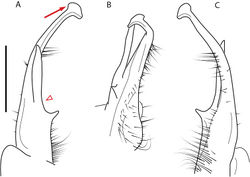Nannaria tsuga
| Notice: | This page is derived from the original publication listed below, whose author(s) should always be credited. Further contributors may edit and improve the content of this page and, consequently, need to be credited as well (see page history). Any assessment of factual correctness requires a careful review of the original article as well as of subsequent contributions.
If you are uncertain whether your planned contribution is correct or not, we suggest that you use the associated discussion page instead of editing the page directly. This page should be cited as follows (rationale):
Citation formats to copy and paste
BibTeX: @article{Means2021ZooKeys1030, RIS/ Endnote: TY - JOUR Wikipedia/ Citizendium: <ref name="Means2021ZooKeys1030">{{Citation See also the citation download page at the journal. |
Ordo: Polydesmida
Familia: Xystodesmidae
Genus: Nannaria
Name
Nannaria tsuga Means & Hennen & Marek, 2021 sp. nov. – Wikispecies link – ZooBank link – Pensoft Profile
Material examined
Holotype: United States – Tennessee • ♂; Sullivan County, Bristol, Steele Creek Park, along Hemlock Hollow Trail; 36.5703°N, -82.2356°W; elev. 506 m; 11 June 2018; hand collected; D. Hennen leg.; VTEC MPE04047.
Paratypes: United States – Tennessee • 2 ♂♂; same collection data as holotype; VTEC MPE04048, 4049 • 1 ♂; same collection data as holotype; VMNH MPE04311 • 1 ♀; same collection data as holotype; VTEC MPE04043 • 1 ♀; same collection data as holotype; VMNH MPE04050. For detailed collection data see Suppl. material 7.
Diagnosis
Adult males of Nannaria tsuga sp. nov. are distinct from other Nannaria and the nearby N. aenigma, based on the following combination of characters: Gonopods. Gonopodal acropodite gently curving medially before apex, not nearly straight as in N. ambulatrix sp. nov. Distal zone short, directed dorsomedially, with large, lobed lateral flange (Fig. 94A, red arrow), not with triangular lateral flange as in N. ambulatrix sp. nov., or without flange and serpentine as in N. aenigma. Telopodite basal zone height < 1/2 length of acropodite, not enlarged, ca. 1/2 length as in N. ambulatrix sp. nov., or reduced, ca. 1/6 length as in N. aenigma. Prefemur with straight, laminate prefemoral process, separated widely from projected, with blunt prefemoral spine (Fig. 94A, red triangle), prefemoral process not arising dorsomedially from small, sharp prefemoral spine as in N. ambulatrix sp. nov. Color. Tergites with orange paranotal spots (Fig. 95). Black background. Dorsum of collum smooth with orange caudal margin.
Measurements
♂ holotype (VTEC, MPE04047): BL = 33.9, CW = 4.3, IW = 2.0, ISW = 1.0, B11W = 5.2, B11H = 3.0; ♀ paratype (VTEC, MPE04043): BL = 31.1, CW = 3.8, IW = 2.6, ISW – 1.1, B11W = 4.9, B11H = 3.8.
Variation
No known variation.
Distribution
Known only from the type locality (Tennessee: Sullivan County, Suppl. material 7; Fig. 126). Distribution area: N/A; status: MRE.
Ecology
Individuals of Nannaria tsuga sp. nov. were collected from a mesic mixed hardwood and hemlock forest, composed of, in addition to hemlock, oak, beech, and buckeye. Individuals were found under moist litter on a hillside.
Etymology
This species is named for the habitat in which it was discovered, a hemlock grove. The specific name is derived from the name Tsuga Carrière, the genus containing hemlock trees, and is a noun in apposition.
Type locality
United States, Tennessee, Sullivan County, Bristol, Steele Creek Park, along Hemlock Hollow Trail, 36.5703°N, -82.2356°W.
Original Description
- Means, J; Hennen, D; Marek, P; 2021: A revision of the minor species group in the millipede genus Nannaria Chamberlin, 1918 (Diplopoda, Polydesmida, Xystodesmidae) ZooKeys, 1030: 1-180. doi
Images
|


